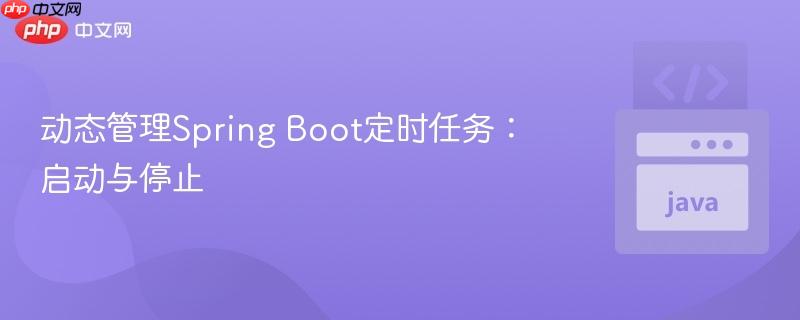
本文旨在提供一种动态管理Spring Boot定时任务的解决方案,允许根据客户端请求动态启动和停止任务。通过维护一个标志位,并在定时任务中检查该标志位,可以避免频繁地启动和停止任务,从而简化代码并提高效率。这种方法特别适用于任务逻辑相同但需要根据不同客户端配置执行的任务。
在实际应用中,我们经常遇到需要动态控制定时任务的场景,例如,根据用户的操作或者外部系统的状态来启动或停止某个任务。Spring Boot提供了强大的定时任务支持,但如何灵活地管理这些任务,使其能够根据需求动态地运行和停止,是一个值得探讨的问题。
以下提供一种基于标志位控制的动态定时任务管理方案,该方案避免了频繁启动和停止任务,提高了效率和可维护性。
该方案的核心思想是:保持定时任务持续运行,通过一个标志位来控制任务是否执行实际的业务逻辑。 当需要启动任务时,设置标志位为true;当需要停止任务时,设置标志位为false。 在定时任务的执行逻辑中,首先检查该标志位,如果为true,则执行业务逻辑;否则,直接返回。
定义一个服务来管理标志位: 创建一个FlagService,用于存储和管理每个客户端的标志位。可以使用Map来存储客户端ID和对应的标志位,或者使用数据库持久化这些信息。
import org.springframework.stereotype.Service;
import java.util.Map;
import java.util.concurrent.ConcurrentHashMap;
@Service
public class FlagService {
private final Map<String, Boolean> clientFlags = new ConcurrentHashMap<>();
public void enableScheduler(String clientId) {
clientFlags.put(clientId, true);
}
public void disableScheduler(String clientId) {
clientFlags.put(clientId, false);
}
public boolean isSchedulerEnabled(String clientId) {
return clientFlags.getOrDefault(clientId, false); // 默认false
}
}创建Controller来处理启动和停止请求: 创建一个SchedulerController,提供start和stop接口,用于接收客户端的启动和停止请求。在这些接口中,调用FlagService来设置对应的标志位。
import org.springframework.beans.factory.annotation.Autowired;
import org.springframework.http.HttpStatus;
import org.springframework.http.ResponseEntity;
import org.springframework.web.bind.annotation.RequestMapping;
import org.springframework.web.bind.annotation.RequestParam;
import org.springframework.web.bind.annotation.RestController;
@RestController
public class SchedulerController {
@Autowired
private FlagService flagService;
@RequestMapping("start")
public ResponseEntity<Void> start(@RequestParam String clientId) {
flagService.enableScheduler(clientId);
return new ResponseEntity<>(HttpStatus.OK);
}
@RequestMapping("stop")
public ResponseEntity<Void> stop(@RequestParam String clientId) {
flagService.disableScheduler(clientId);
return new ResponseEntity<>(HttpStatus.OK);
}
}实现定时任务: 创建一个定时任务,使用@Scheduled注解来定义定时执行的规则。 在任务的执行逻辑中,首先调用FlagService来检查对应客户端的标志位,如果为true,则执行业务逻辑;否则,直接返回。
import org.springframework.beans.factory.annotation.Autowired;
import org.springframework.scheduling.annotation.Scheduled;
import org.springframework.stereotype.Component;
@Component
public class MyTask {
@Autowired
private FlagService flagService;
@Scheduled(fixedDelay = 5000) // 每5秒执行一次
public void myWorkerFunction() {
// 模拟客户端ID
String clientId = "clientA"; // 实际应用中,需要根据上下文获取clientId
if (flagService.isSchedulerEnabled(clientId)) {
// 执行业务逻辑
System.out.println("Task executed for client: " + clientId);
// ... 具体的业务逻辑 ...
} else {
// 不执行业务逻辑
System.out.println("Task skipped for client: " + clientId);
}
}
}注意: 确保你的Spring Boot应用已经启用了定时任务的支持,需要在启动类上添加@EnableScheduling注解。
import org.springframework.boot.SpringApplication;
import org.springframework.boot.autoconfigure.SpringBootApplication;
import org.springframework.scheduling.annotation.EnableScheduling;
@SpringBootApplication
@EnableScheduling
public class MyApplication {
public static void main(String[] args) {
SpringApplication.run(MyApplication.class, args);
}
}完整的示例代码如下:
// FlagService.java
import org.springframework.stereotype.Service;
import java.util.Map;
import java.util.concurrent.ConcurrentHashMap;
@Service
public class FlagService {
private final Map<String, Boolean> clientFlags = new ConcurrentHashMap<>();
public void enableScheduler(String clientId) {
clientFlags.put(clientId, true);
}
public void disableScheduler(String clientId) {
clientFlags.put(clientId, false);
}
public boolean isSchedulerEnabled(String clientId) {
return clientFlags.getOrDefault(clientId, false); // 默认false
}
}
// SchedulerController.java
import org.springframework.beans.factory.annotation.Autowired;
import org.springframework.http.HttpStatus;
import org.springframework.http.ResponseEntity;
import org.springframework.web.bind.annotation.RequestMapping;
import org.springframework.web.bind.annotation.RequestParam;
import org.springframework.web.bind.annotation.RestController;
@RestController
public class SchedulerController {
@Autowired
private FlagService flagService;
@RequestMapping("start")
public ResponseEntity<Void> start(@RequestParam String clientId) {
flagService.enableScheduler(clientId);
return new ResponseEntity<>(HttpStatus.OK);
}
@RequestMapping("stop")
public ResponseEntity<Void> stop(@RequestParam String clientId) {
flagService.disableScheduler(clientId);
return new ResponseEntity<>(HttpStatus.OK);
}
}
// MyTask.java
import org.springframework.beans.factory.annotation.Autowired;
import org.springframework.scheduling.annotation.Scheduled;
import org.springframework.stereotype.Component;
@Component
public class MyTask {
@Autowired
private FlagService flagService;
@Scheduled(fixedDelay = 5000) // 每5秒执行一次
public void myWorkerFunction() {
// 模拟客户端ID
String clientId = "clientA"; // 实际应用中,需要根据上下文获取clientId
if (flagService.isSchedulerEnabled(clientId)) {
// 执行业务逻辑
System.out.println("Task executed for client: " + clientId);
// ... 具体的业务逻辑 ...
} else {
// 不执行业务逻辑
System.out.println("Task skipped for client: " + clientId);
}
}
}
// MyApplication.java
import org.springframework.boot.SpringApplication;
import org.springframework.boot.autoconfigure.SpringBootApplication;
import org.springframework.scheduling.annotation.EnableScheduling;
@SpringBootApplication
@EnableScheduling
public class MyApplication {
public static void main(String[] args) {
SpringApplication.run(MyApplication.class, args);
}
}通过使用标志位来控制定时任务的执行,可以避免频繁地启动和停止任务,从而简化代码并提高效率。 这种方法特别适用于任务逻辑相同但需要根据不同客户端配置执行的场景。 在实际应用中,需要根据具体的业务场景进行适当的调整和优化。 此外,还可以考虑使用更高级的调度框架,如Quartz,来实现更复杂的定时任务管理需求。
以上就是动态管理Spring Boot定时任务:启动与停止的详细内容,更多请关注php中文网其它相关文章!

每个人都需要一台速度更快、更稳定的 PC。随着时间的推移,垃圾文件、旧注册表数据和不必要的后台进程会占用资源并降低性能。幸运的是,许多工具可以让 Windows 保持平稳运行。

Copyright 2014-2025 https://www.php.cn/ All Rights Reserved | php.cn | 湘ICP备2023035733号